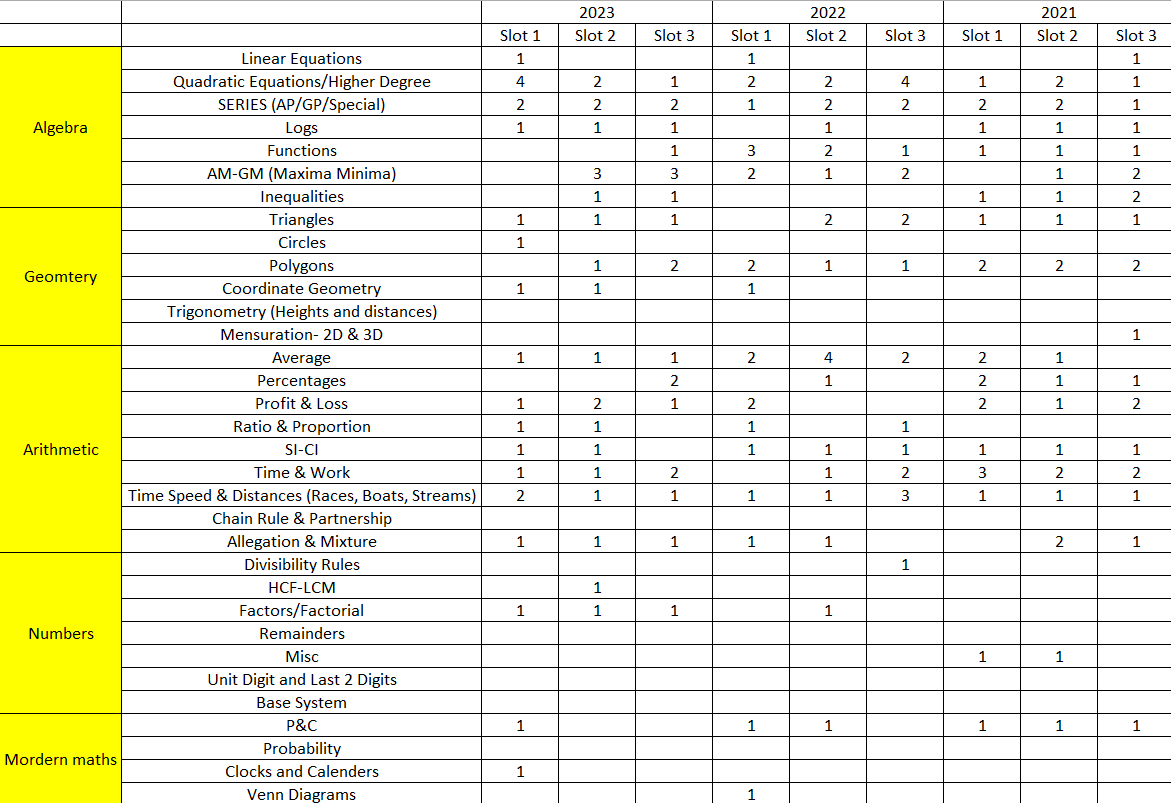Past years CAT Exam Analysis: Latest Trends & Question Types
- Quantifiers
- 22nd March 2024
Watch this video if you want to skip reading the whole blog. Below is an in-depth syllabus analysis of the CAT Exam.
Key Takeaways:
- The CAT exam pattern and question types have changed over the past years.
- By understanding the latest trends, you can align your preparation with the current exam pattern.
- Knowing the different question types in the CAT exam will help you develop effective strategies to tackle them.
- Staying updated with the changing patterns will give you an edge over other CAT exam aspirants.
- Analyzing the past trends will help you optimize your preparation and maximize your chances of success in the CAT exam.
CAT Exam Pattern Trends
Important Dates
Mark your calendars with these important CAT dates (tentative):
CAT Registration Start Date: August 1, 2024
CAT Registration End Date: September 23, 2024
CAT Exam Date: November 24, 2024
No. of Questions | 66 (VARC-24, DILR-20, QA-22) |
Sections in Exam | 3; VARC, DILR and QA |
Exam Duration | 2 hours |
Time Allotted per Section | 40 minutes |
Slots for Exam | 3 |
Mode of Exam | Computer-based Exam |
Medium of Instruction | English |
Types of Questions | MCQ and TITA |
CAT Marking Scheme | +3 for every right answer -1 for every wrong answer TITA has no negative marking |
Changes in CAT Exam Pattern
- Introduction of Non-MCQs: One significant change in the CAT exam pattern is the introduction of non-MCQs (Multiple Choice Questions) in addition to the traditional MCQs. Non-MCQs require candidates to type in their answers instead of selecting options, which tests their problem-solving and calculation abilities.
Section | Questions | MCQ | Non-MCQ | |
VARC | 24 | 20 | 4 | 16 questions of RC – 4 passages of 4 questions each. 8 Questions of Verbal ability – Parajumbles, para completions, parasummary and odd sentence out |
DILR | 20 | 14 | 6 | 4 sets of 5 questions each Areas questioned – Bar Graph, Arrangements, Missing Data and Puzzles (Games) |
QA | 22 | 15 | 7 | Dominated by questions of Arithmetic and Algebra. |
Total | 66 | 49 | 17 |
- Variation in Sectional Composition: The CAT exam pattern has witnessed variations in the number of sections and their composition. In some years, there have been three sections, while in others, there have been two. The weightage and number of questions in each section have also been subject to change.
- Introduction of On-screen Calculator: To aid candidates in solving complex calculations efficiently, the CAT exam has incorporated an on-screen calculator. This has been a significant change that allows candidates to focus on logical reasoning and problem-solving without the burden of manual calculations.
CAT Exam Structure and CAT Exam Question Types
1. Multiple Choice Questions (MCQs)
We with our expert faculty compiled ideal CAT 2024 preparation materials
Quant: https://quantifiers.in/quantitative-aptitude/
2. Data Interpretation (DI) Questions
Different types of sets with video explanations to understand the best methodologies are very important.
3. Logical Reasoning (LR) Questions
4. Verbal Ability (VA) Questions
5. Quantitative Aptitude (QA) Questions

Question Type | Format |
Multiple Choice Questions (MCQs) | Choose the correct option from given choices |
Data Interpretation (DI) Questions | Analyze and interpret data from tables, graphs, and charts |
Logical Reasoning (LR) Questions | Solve puzzles, analyze patterns, evaluate arguments |
Verbal Ability (VA) Questions | Grammar rules, vocabulary usage, reading comprehension |
Quantitative Aptitude (QA) Questions | Mathematical and problem-solving skills |
Conclusion
Practice Mock Tests: https://quantifiers.in/mini-mocks/
Daily Targets link: https://docs.google.com/forms/u/0/d/e/1FAIpQLScc6boBhAz4TEPaf7FbuZVXVGciXXMZwUxkpiwCWK3gGFEicg/alreadyresponded?usp=send_form
Links for practice: https://quantifiers.in/verbal-ability/
Critical Reasoning: https://quantifiers.in/critical-reasoning-tests/
Tests Verbal: https://quantifiers.in/verbal-ability-tests/
FAQ
To connect with us, for mentorship and daily test practice
DM us on Instagram or WhatsApp. We reply back 24/7. Get your CAT prep started

